University Air Cargo: Logistics and Supply Chain Management Report
VerifiedAdded on 2023/01/17
|11
|2732
|81
Report
AI Summary
This report provides a comprehensive overview of the air cargo industry, focusing on logistics and supply chain management. It explores the definition and significance of air cargo, its modern applications, and the analysis of the air cargo market, including market volume and growth trends. The report investigates the impact of cargo operations on departure and on-time performance, particularly for combination carriers, and examines factors influencing airport choice, such as location and market demand. It also delves into the legal and regulatory aspects of air cargo. The analysis includes insights from various studies and reports, offering a detailed understanding of the industry's dynamics and challenges. The report highlights the interplay between passenger and cargo operations, emphasizing the importance of considering business models within the entire continuum of passenger and cargo operations. The report is a valuable resource for students seeking to understand the complexities of the air cargo sector.
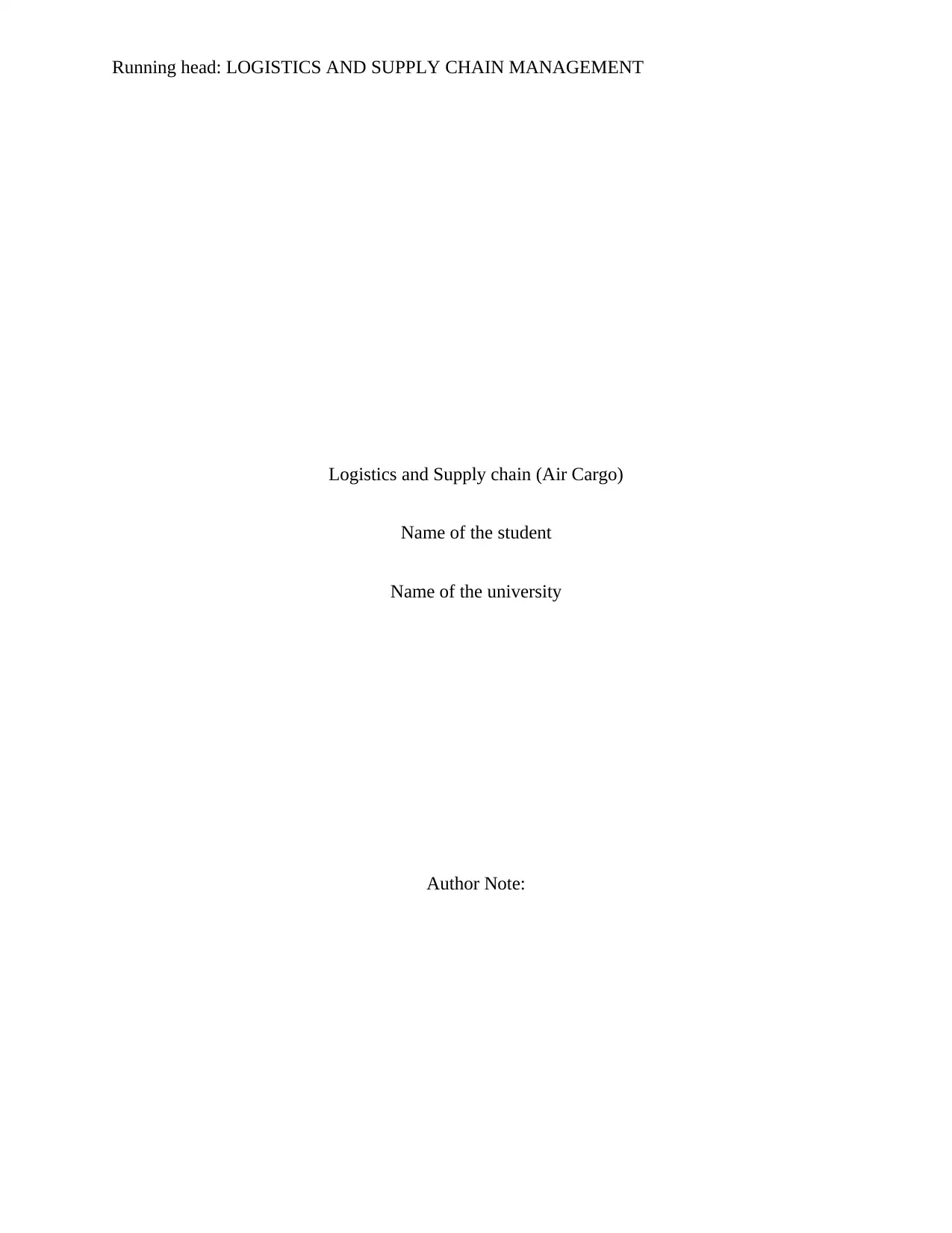
Running head: LOGISTICS AND SUPPLY CHAIN MANAGEMENT
Logistics and Supply chain (Air Cargo)
Name of the student
Name of the university
Author Note:
Logistics and Supply chain (Air Cargo)
Name of the student
Name of the university
Author Note:
Paraphrase This Document
Need a fresh take? Get an instant paraphrase of this document with our AI Paraphraser
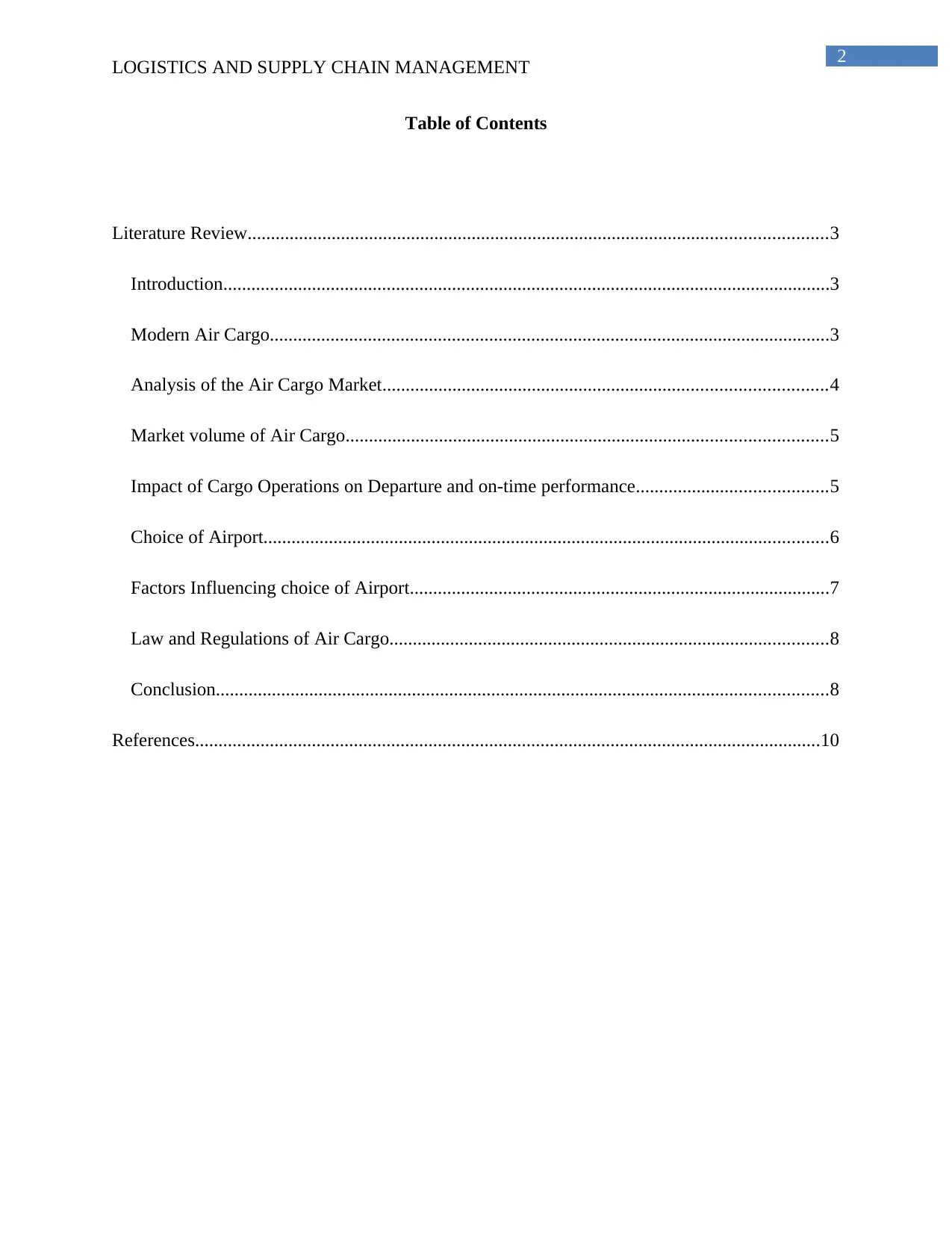
2
LOGISTICS AND SUPPLY CHAIN MANAGEMENT
Table of Contents
Literature Review............................................................................................................................3
Introduction..................................................................................................................................3
Modern Air Cargo........................................................................................................................3
Analysis of the Air Cargo Market...............................................................................................4
Market volume of Air Cargo.......................................................................................................5
Impact of Cargo Operations on Departure and on-time performance.........................................5
Choice of Airport.........................................................................................................................6
Factors Influencing choice of Airport..........................................................................................7
Law and Regulations of Air Cargo..............................................................................................8
Conclusion...................................................................................................................................8
References......................................................................................................................................10
LOGISTICS AND SUPPLY CHAIN MANAGEMENT
Table of Contents
Literature Review............................................................................................................................3
Introduction..................................................................................................................................3
Modern Air Cargo........................................................................................................................3
Analysis of the Air Cargo Market...............................................................................................4
Market volume of Air Cargo.......................................................................................................5
Impact of Cargo Operations on Departure and on-time performance.........................................5
Choice of Airport.........................................................................................................................6
Factors Influencing choice of Airport..........................................................................................7
Law and Regulations of Air Cargo..............................................................................................8
Conclusion...................................................................................................................................8
References......................................................................................................................................10
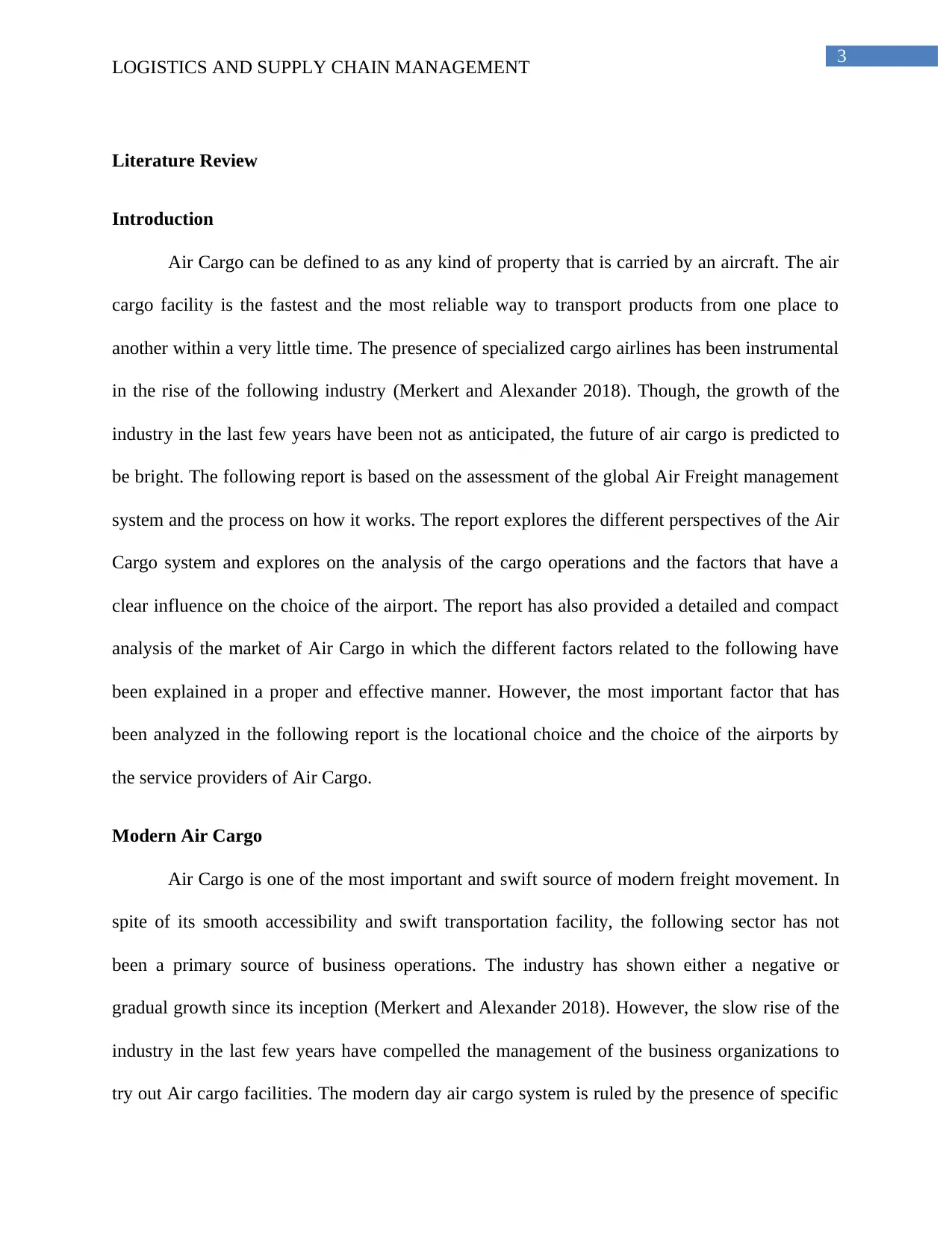
3
LOGISTICS AND SUPPLY CHAIN MANAGEMENT
Literature Review
Introduction
Air Cargo can be defined to as any kind of property that is carried by an aircraft. The air
cargo facility is the fastest and the most reliable way to transport products from one place to
another within a very little time. The presence of specialized cargo airlines has been instrumental
in the rise of the following industry (Merkert and Alexander 2018). Though, the growth of the
industry in the last few years have been not as anticipated, the future of air cargo is predicted to
be bright. The following report is based on the assessment of the global Air Freight management
system and the process on how it works. The report explores the different perspectives of the Air
Cargo system and explores on the analysis of the cargo operations and the factors that have a
clear influence on the choice of the airport. The report has also provided a detailed and compact
analysis of the market of Air Cargo in which the different factors related to the following have
been explained in a proper and effective manner. However, the most important factor that has
been analyzed in the following report is the locational choice and the choice of the airports by
the service providers of Air Cargo.
Modern Air Cargo
Air Cargo is one of the most important and swift source of modern freight movement. In
spite of its smooth accessibility and swift transportation facility, the following sector has not
been a primary source of business operations. The industry has shown either a negative or
gradual growth since its inception (Merkert and Alexander 2018). However, the slow rise of the
industry in the last few years have compelled the management of the business organizations to
try out Air cargo facilities. The modern day air cargo system is ruled by the presence of specific
LOGISTICS AND SUPPLY CHAIN MANAGEMENT
Literature Review
Introduction
Air Cargo can be defined to as any kind of property that is carried by an aircraft. The air
cargo facility is the fastest and the most reliable way to transport products from one place to
another within a very little time. The presence of specialized cargo airlines has been instrumental
in the rise of the following industry (Merkert and Alexander 2018). Though, the growth of the
industry in the last few years have been not as anticipated, the future of air cargo is predicted to
be bright. The following report is based on the assessment of the global Air Freight management
system and the process on how it works. The report explores the different perspectives of the Air
Cargo system and explores on the analysis of the cargo operations and the factors that have a
clear influence on the choice of the airport. The report has also provided a detailed and compact
analysis of the market of Air Cargo in which the different factors related to the following have
been explained in a proper and effective manner. However, the most important factor that has
been analyzed in the following report is the locational choice and the choice of the airports by
the service providers of Air Cargo.
Modern Air Cargo
Air Cargo is one of the most important and swift source of modern freight movement. In
spite of its smooth accessibility and swift transportation facility, the following sector has not
been a primary source of business operations. The industry has shown either a negative or
gradual growth since its inception (Merkert and Alexander 2018). However, the slow rise of the
industry in the last few years have compelled the management of the business organizations to
try out Air cargo facilities. The modern day air cargo system is ruled by the presence of specific
⊘ This is a preview!⊘
Do you want full access?
Subscribe today to unlock all pages.

Trusted by 1+ million students worldwide
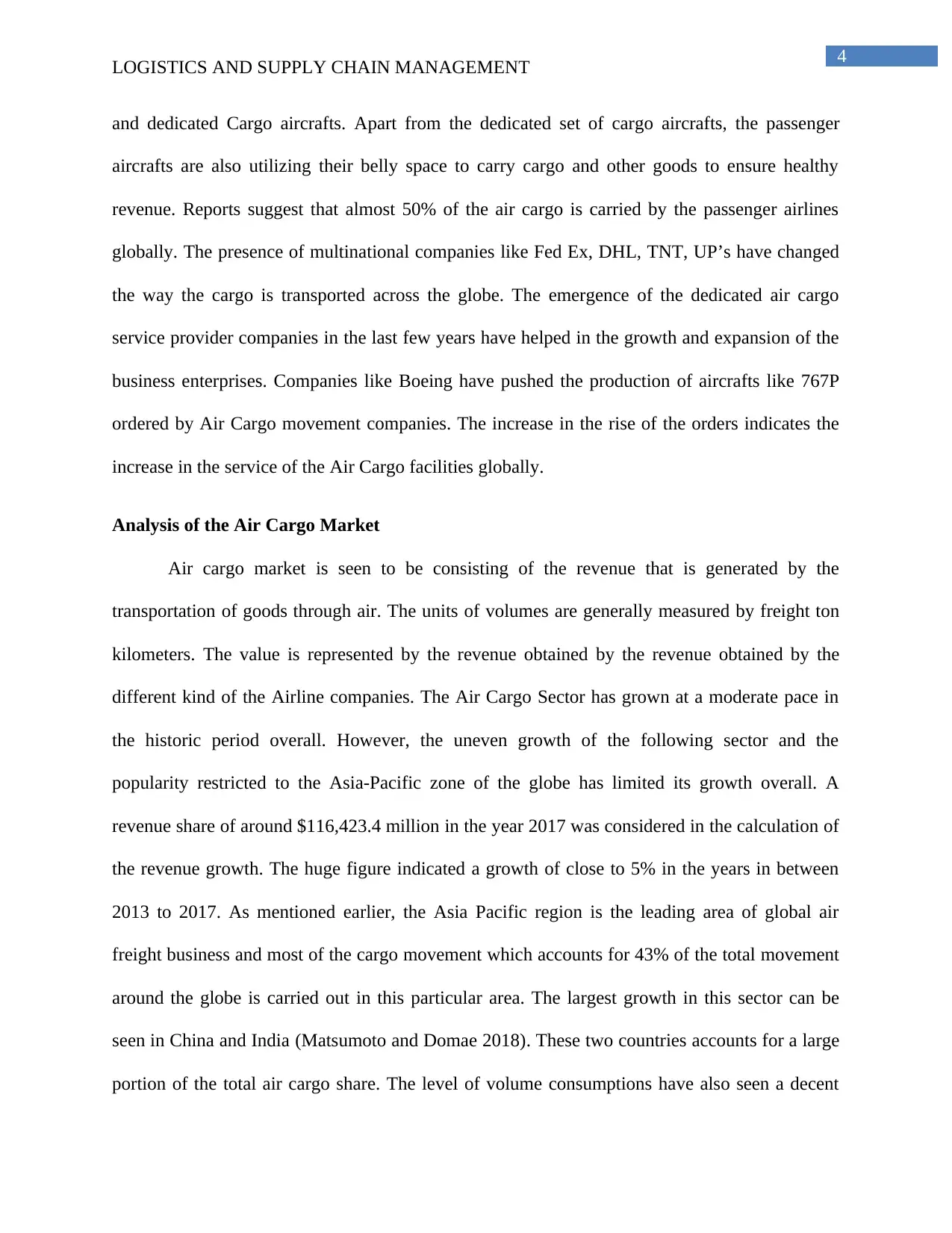
4
LOGISTICS AND SUPPLY CHAIN MANAGEMENT
and dedicated Cargo aircrafts. Apart from the dedicated set of cargo aircrafts, the passenger
aircrafts are also utilizing their belly space to carry cargo and other goods to ensure healthy
revenue. Reports suggest that almost 50% of the air cargo is carried by the passenger airlines
globally. The presence of multinational companies like Fed Ex, DHL, TNT, UP’s have changed
the way the cargo is transported across the globe. The emergence of the dedicated air cargo
service provider companies in the last few years have helped in the growth and expansion of the
business enterprises. Companies like Boeing have pushed the production of aircrafts like 767P
ordered by Air Cargo movement companies. The increase in the rise of the orders indicates the
increase in the service of the Air Cargo facilities globally.
Analysis of the Air Cargo Market
Air cargo market is seen to be consisting of the revenue that is generated by the
transportation of goods through air. The units of volumes are generally measured by freight ton
kilometers. The value is represented by the revenue obtained by the revenue obtained by the
different kind of the Airline companies. The Air Cargo Sector has grown at a moderate pace in
the historic period overall. However, the uneven growth of the following sector and the
popularity restricted to the Asia-Pacific zone of the globe has limited its growth overall. A
revenue share of around $116,423.4 million in the year 2017 was considered in the calculation of
the revenue growth. The huge figure indicated a growth of close to 5% in the years in between
2013 to 2017. As mentioned earlier, the Asia Pacific region is the leading area of global air
freight business and most of the cargo movement which accounts for 43% of the total movement
around the globe is carried out in this particular area. The largest growth in this sector can be
seen in China and India (Matsumoto and Domae 2018). These two countries accounts for a large
portion of the total air cargo share. The level of volume consumptions have also seen a decent
LOGISTICS AND SUPPLY CHAIN MANAGEMENT
and dedicated Cargo aircrafts. Apart from the dedicated set of cargo aircrafts, the passenger
aircrafts are also utilizing their belly space to carry cargo and other goods to ensure healthy
revenue. Reports suggest that almost 50% of the air cargo is carried by the passenger airlines
globally. The presence of multinational companies like Fed Ex, DHL, TNT, UP’s have changed
the way the cargo is transported across the globe. The emergence of the dedicated air cargo
service provider companies in the last few years have helped in the growth and expansion of the
business enterprises. Companies like Boeing have pushed the production of aircrafts like 767P
ordered by Air Cargo movement companies. The increase in the rise of the orders indicates the
increase in the service of the Air Cargo facilities globally.
Analysis of the Air Cargo Market
Air cargo market is seen to be consisting of the revenue that is generated by the
transportation of goods through air. The units of volumes are generally measured by freight ton
kilometers. The value is represented by the revenue obtained by the revenue obtained by the
different kind of the Airline companies. The Air Cargo Sector has grown at a moderate pace in
the historic period overall. However, the uneven growth of the following sector and the
popularity restricted to the Asia-Pacific zone of the globe has limited its growth overall. A
revenue share of around $116,423.4 million in the year 2017 was considered in the calculation of
the revenue growth. The huge figure indicated a growth of close to 5% in the years in between
2013 to 2017. As mentioned earlier, the Asia Pacific region is the leading area of global air
freight business and most of the cargo movement which accounts for 43% of the total movement
around the globe is carried out in this particular area. The largest growth in this sector can be
seen in China and India (Matsumoto and Domae 2018). These two countries accounts for a large
portion of the total air cargo share. The level of volume consumptions have also seen a decent
Paraphrase This Document
Need a fresh take? Get an instant paraphrase of this document with our AI Paraphraser
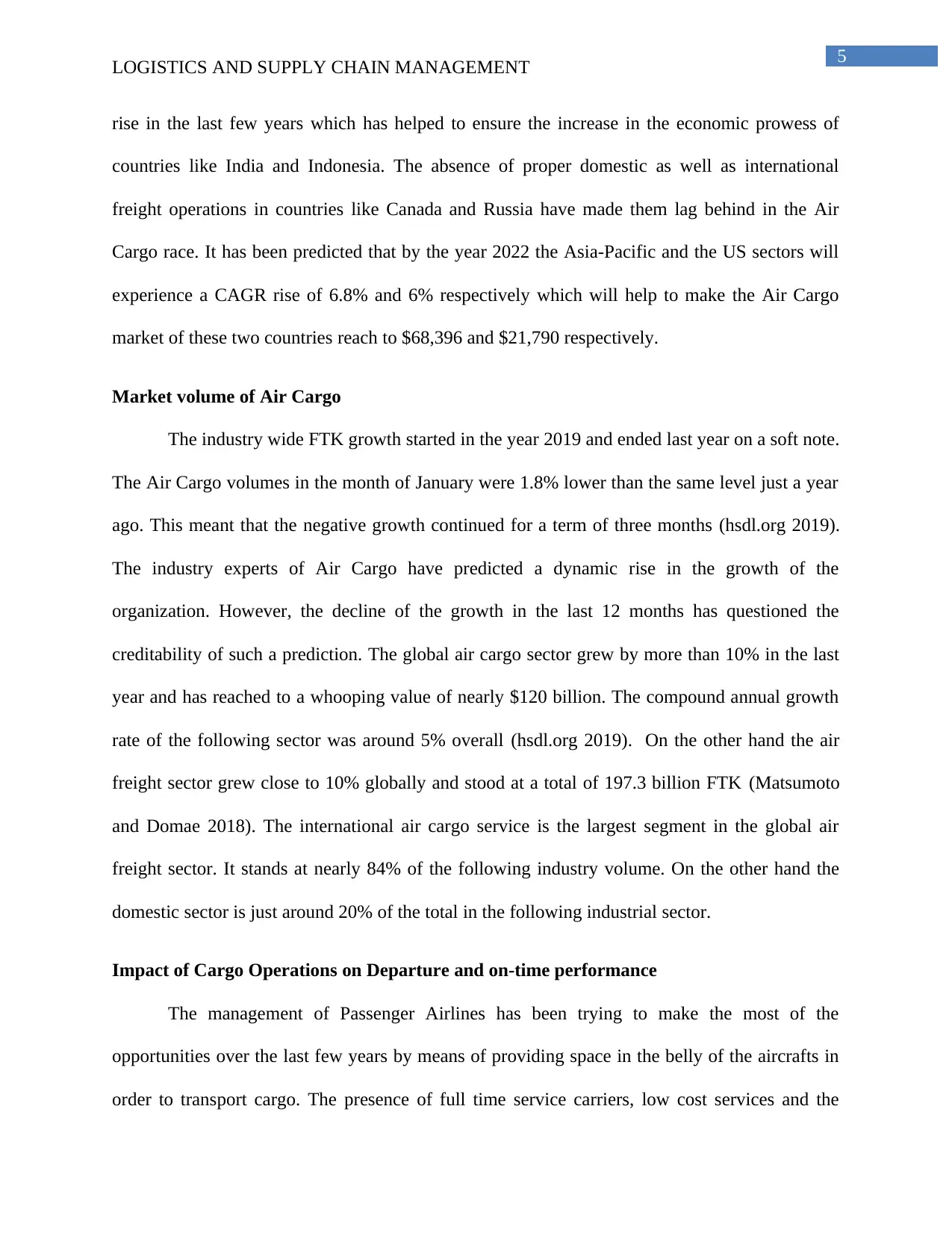
5
LOGISTICS AND SUPPLY CHAIN MANAGEMENT
rise in the last few years which has helped to ensure the increase in the economic prowess of
countries like India and Indonesia. The absence of proper domestic as well as international
freight operations in countries like Canada and Russia have made them lag behind in the Air
Cargo race. It has been predicted that by the year 2022 the Asia-Pacific and the US sectors will
experience a CAGR rise of 6.8% and 6% respectively which will help to make the Air Cargo
market of these two countries reach to $68,396 and $21,790 respectively.
Market volume of Air Cargo
The industry wide FTK growth started in the year 2019 and ended last year on a soft note.
The Air Cargo volumes in the month of January were 1.8% lower than the same level just a year
ago. This meant that the negative growth continued for a term of three months (hsdl.org 2019).
The industry experts of Air Cargo have predicted a dynamic rise in the growth of the
organization. However, the decline of the growth in the last 12 months has questioned the
creditability of such a prediction. The global air cargo sector grew by more than 10% in the last
year and has reached to a whooping value of nearly $120 billion. The compound annual growth
rate of the following sector was around 5% overall (hsdl.org 2019). On the other hand the air
freight sector grew close to 10% globally and stood at a total of 197.3 billion FTK (Matsumoto
and Domae 2018). The international air cargo service is the largest segment in the global air
freight sector. It stands at nearly 84% of the following industry volume. On the other hand the
domestic sector is just around 20% of the total in the following industrial sector.
Impact of Cargo Operations on Departure and on-time performance
The management of Passenger Airlines has been trying to make the most of the
opportunities over the last few years by means of providing space in the belly of the aircrafts in
order to transport cargo. The presence of full time service carriers, low cost services and the
LOGISTICS AND SUPPLY CHAIN MANAGEMENT
rise in the last few years which has helped to ensure the increase in the economic prowess of
countries like India and Indonesia. The absence of proper domestic as well as international
freight operations in countries like Canada and Russia have made them lag behind in the Air
Cargo race. It has been predicted that by the year 2022 the Asia-Pacific and the US sectors will
experience a CAGR rise of 6.8% and 6% respectively which will help to make the Air Cargo
market of these two countries reach to $68,396 and $21,790 respectively.
Market volume of Air Cargo
The industry wide FTK growth started in the year 2019 and ended last year on a soft note.
The Air Cargo volumes in the month of January were 1.8% lower than the same level just a year
ago. This meant that the negative growth continued for a term of three months (hsdl.org 2019).
The industry experts of Air Cargo have predicted a dynamic rise in the growth of the
organization. However, the decline of the growth in the last 12 months has questioned the
creditability of such a prediction. The global air cargo sector grew by more than 10% in the last
year and has reached to a whooping value of nearly $120 billion. The compound annual growth
rate of the following sector was around 5% overall (hsdl.org 2019). On the other hand the air
freight sector grew close to 10% globally and stood at a total of 197.3 billion FTK (Matsumoto
and Domae 2018). The international air cargo service is the largest segment in the global air
freight sector. It stands at nearly 84% of the following industry volume. On the other hand the
domestic sector is just around 20% of the total in the following industrial sector.
Impact of Cargo Operations on Departure and on-time performance
The management of Passenger Airlines has been trying to make the most of the
opportunities over the last few years by means of providing space in the belly of the aircrafts in
order to transport cargo. The presence of full time service carriers, low cost services and the
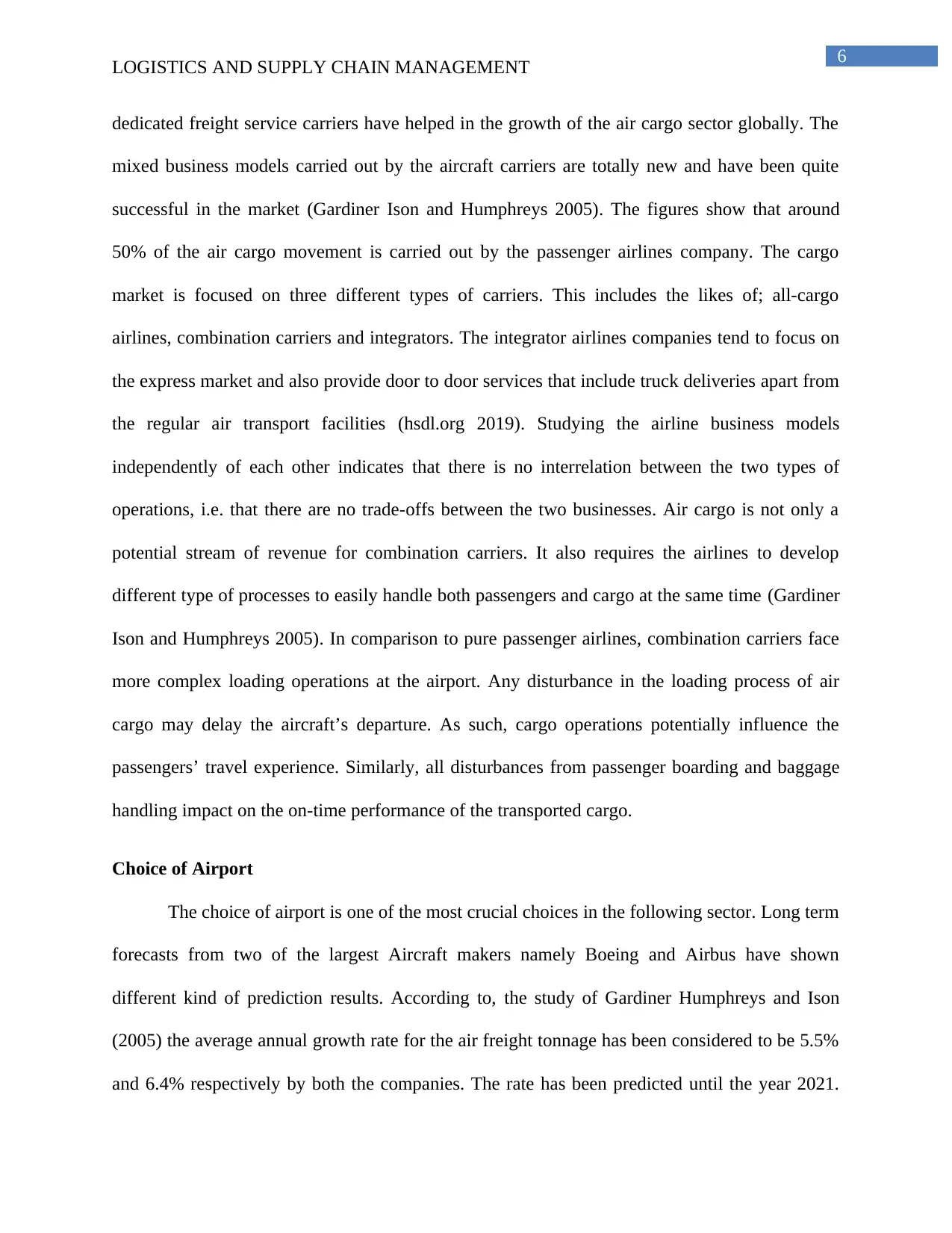
6
LOGISTICS AND SUPPLY CHAIN MANAGEMENT
dedicated freight service carriers have helped in the growth of the air cargo sector globally. The
mixed business models carried out by the aircraft carriers are totally new and have been quite
successful in the market (Gardiner Ison and Humphreys 2005). The figures show that around
50% of the air cargo movement is carried out by the passenger airlines company. The cargo
market is focused on three different types of carriers. This includes the likes of; all-cargo
airlines, combination carriers and integrators. The integrator airlines companies tend to focus on
the express market and also provide door to door services that include truck deliveries apart from
the regular air transport facilities (hsdl.org 2019). Studying the airline business models
independently of each other indicates that there is no interrelation between the two types of
operations, i.e. that there are no trade-offs between the two businesses. Air cargo is not only a
potential stream of revenue for combination carriers. It also requires the airlines to develop
different type of processes to easily handle both passengers and cargo at the same time (Gardiner
Ison and Humphreys 2005). In comparison to pure passenger airlines, combination carriers face
more complex loading operations at the airport. Any disturbance in the loading process of air
cargo may delay the aircraft’s departure. As such, cargo operations potentially influence the
passengers’ travel experience. Similarly, all disturbances from passenger boarding and baggage
handling impact on the on-time performance of the transported cargo.
Choice of Airport
The choice of airport is one of the most crucial choices in the following sector. Long term
forecasts from two of the largest Aircraft makers namely Boeing and Airbus have shown
different kind of prediction results. According to, the study of Gardiner Humphreys and Ison
(2005) the average annual growth rate for the air freight tonnage has been considered to be 5.5%
and 6.4% respectively by both the companies. The rate has been predicted until the year 2021.
LOGISTICS AND SUPPLY CHAIN MANAGEMENT
dedicated freight service carriers have helped in the growth of the air cargo sector globally. The
mixed business models carried out by the aircraft carriers are totally new and have been quite
successful in the market (Gardiner Ison and Humphreys 2005). The figures show that around
50% of the air cargo movement is carried out by the passenger airlines company. The cargo
market is focused on three different types of carriers. This includes the likes of; all-cargo
airlines, combination carriers and integrators. The integrator airlines companies tend to focus on
the express market and also provide door to door services that include truck deliveries apart from
the regular air transport facilities (hsdl.org 2019). Studying the airline business models
independently of each other indicates that there is no interrelation between the two types of
operations, i.e. that there are no trade-offs between the two businesses. Air cargo is not only a
potential stream of revenue for combination carriers. It also requires the airlines to develop
different type of processes to easily handle both passengers and cargo at the same time (Gardiner
Ison and Humphreys 2005). In comparison to pure passenger airlines, combination carriers face
more complex loading operations at the airport. Any disturbance in the loading process of air
cargo may delay the aircraft’s departure. As such, cargo operations potentially influence the
passengers’ travel experience. Similarly, all disturbances from passenger boarding and baggage
handling impact on the on-time performance of the transported cargo.
Choice of Airport
The choice of airport is one of the most crucial choices in the following sector. Long term
forecasts from two of the largest Aircraft makers namely Boeing and Airbus have shown
different kind of prediction results. According to, the study of Gardiner Humphreys and Ison
(2005) the average annual growth rate for the air freight tonnage has been considered to be 5.5%
and 6.4% respectively by both the companies. The rate has been predicted until the year 2021.
⊘ This is a preview!⊘
Do you want full access?
Subscribe today to unlock all pages.

Trusted by 1+ million students worldwide
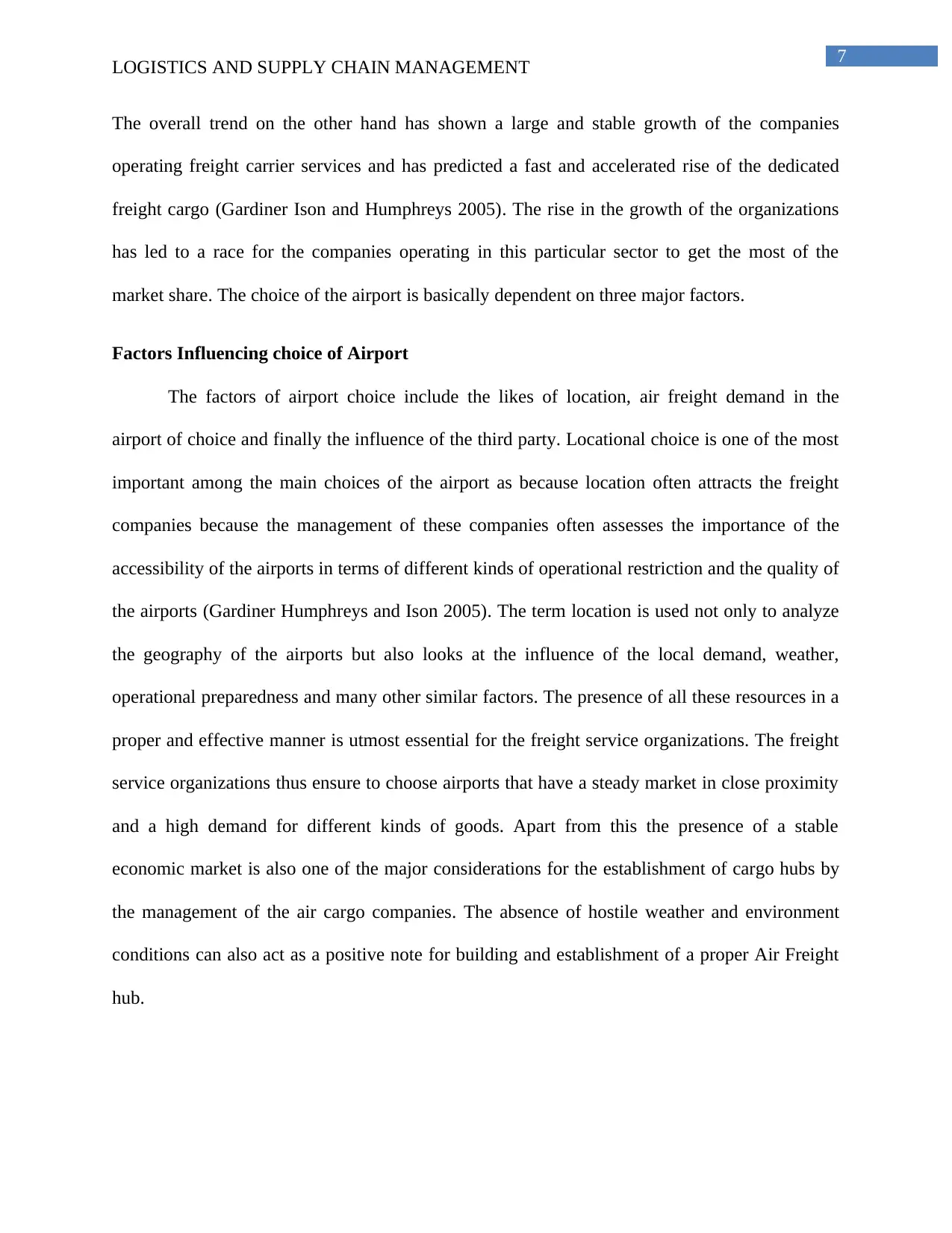
7
LOGISTICS AND SUPPLY CHAIN MANAGEMENT
The overall trend on the other hand has shown a large and stable growth of the companies
operating freight carrier services and has predicted a fast and accelerated rise of the dedicated
freight cargo (Gardiner Ison and Humphreys 2005). The rise in the growth of the organizations
has led to a race for the companies operating in this particular sector to get the most of the
market share. The choice of the airport is basically dependent on three major factors.
Factors Influencing choice of Airport
The factors of airport choice include the likes of location, air freight demand in the
airport of choice and finally the influence of the third party. Locational choice is one of the most
important among the main choices of the airport as because location often attracts the freight
companies because the management of these companies often assesses the importance of the
accessibility of the airports in terms of different kinds of operational restriction and the quality of
the airports (Gardiner Humphreys and Ison 2005). The term location is used not only to analyze
the geography of the airports but also looks at the influence of the local demand, weather,
operational preparedness and many other similar factors. The presence of all these resources in a
proper and effective manner is utmost essential for the freight service organizations. The freight
service organizations thus ensure to choose airports that have a steady market in close proximity
and a high demand for different kinds of goods. Apart from this the presence of a stable
economic market is also one of the major considerations for the establishment of cargo hubs by
the management of the air cargo companies. The absence of hostile weather and environment
conditions can also act as a positive note for building and establishment of a proper Air Freight
hub.
LOGISTICS AND SUPPLY CHAIN MANAGEMENT
The overall trend on the other hand has shown a large and stable growth of the companies
operating freight carrier services and has predicted a fast and accelerated rise of the dedicated
freight cargo (Gardiner Ison and Humphreys 2005). The rise in the growth of the organizations
has led to a race for the companies operating in this particular sector to get the most of the
market share. The choice of the airport is basically dependent on three major factors.
Factors Influencing choice of Airport
The factors of airport choice include the likes of location, air freight demand in the
airport of choice and finally the influence of the third party. Locational choice is one of the most
important among the main choices of the airport as because location often attracts the freight
companies because the management of these companies often assesses the importance of the
accessibility of the airports in terms of different kinds of operational restriction and the quality of
the airports (Gardiner Humphreys and Ison 2005). The term location is used not only to analyze
the geography of the airports but also looks at the influence of the local demand, weather,
operational preparedness and many other similar factors. The presence of all these resources in a
proper and effective manner is utmost essential for the freight service organizations. The freight
service organizations thus ensure to choose airports that have a steady market in close proximity
and a high demand for different kinds of goods. Apart from this the presence of a stable
economic market is also one of the major considerations for the establishment of cargo hubs by
the management of the air cargo companies. The absence of hostile weather and environment
conditions can also act as a positive note for building and establishment of a proper Air Freight
hub.
Paraphrase This Document
Need a fresh take? Get an instant paraphrase of this document with our AI Paraphraser
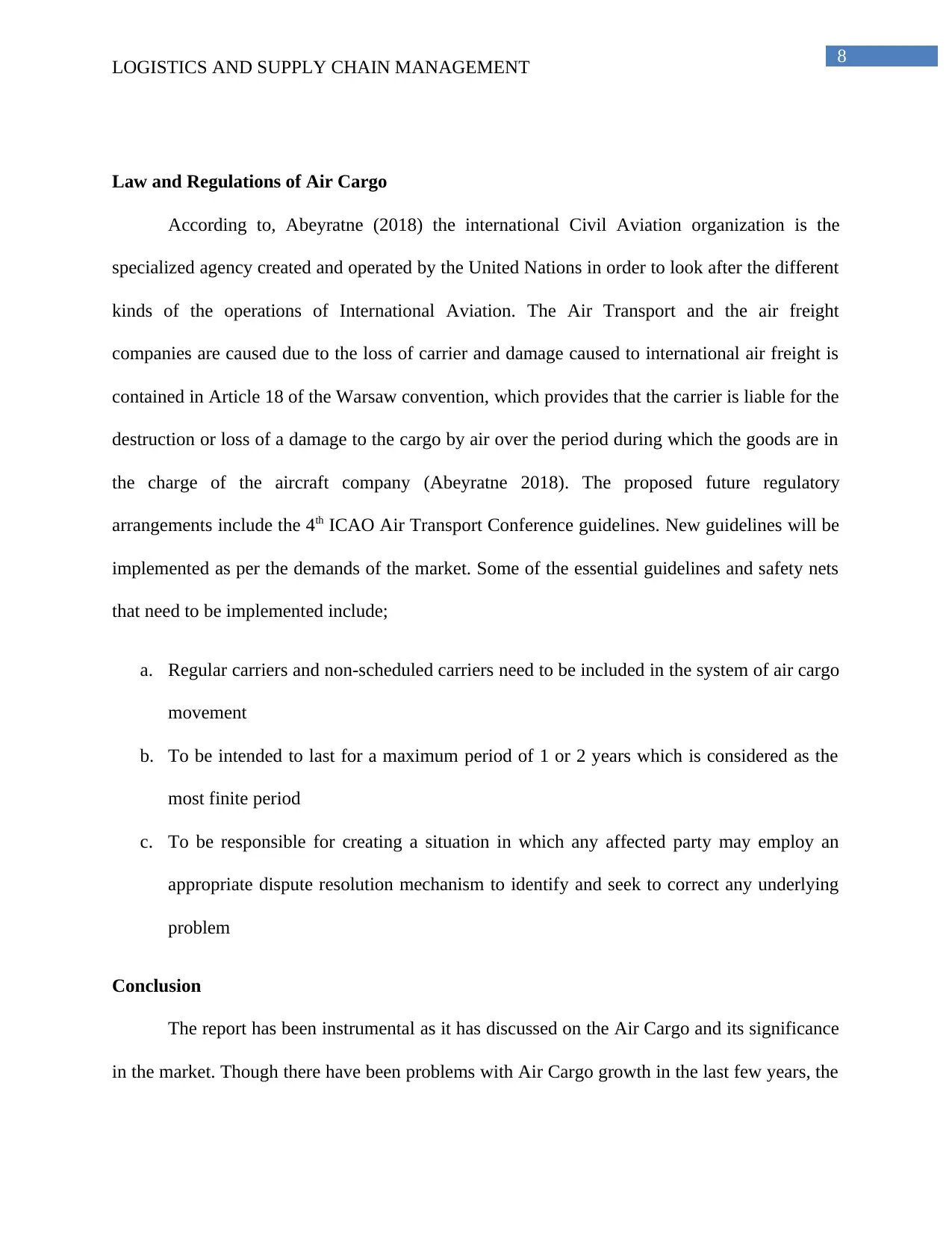
8
LOGISTICS AND SUPPLY CHAIN MANAGEMENT
Law and Regulations of Air Cargo
According to, Abeyratne (2018) the international Civil Aviation organization is the
specialized agency created and operated by the United Nations in order to look after the different
kinds of the operations of International Aviation. The Air Transport and the air freight
companies are caused due to the loss of carrier and damage caused to international air freight is
contained in Article 18 of the Warsaw convention, which provides that the carrier is liable for the
destruction or loss of a damage to the cargo by air over the period during which the goods are in
the charge of the aircraft company (Abeyratne 2018). The proposed future regulatory
arrangements include the 4th ICAO Air Transport Conference guidelines. New guidelines will be
implemented as per the demands of the market. Some of the essential guidelines and safety nets
that need to be implemented include;
a. Regular carriers and non-scheduled carriers need to be included in the system of air cargo
movement
b. To be intended to last for a maximum period of 1 or 2 years which is considered as the
most finite period
c. To be responsible for creating a situation in which any affected party may employ an
appropriate dispute resolution mechanism to identify and seek to correct any underlying
problem
Conclusion
The report has been instrumental as it has discussed on the Air Cargo and its significance
in the market. Though there have been problems with Air Cargo growth in the last few years, the
LOGISTICS AND SUPPLY CHAIN MANAGEMENT
Law and Regulations of Air Cargo
According to, Abeyratne (2018) the international Civil Aviation organization is the
specialized agency created and operated by the United Nations in order to look after the different
kinds of the operations of International Aviation. The Air Transport and the air freight
companies are caused due to the loss of carrier and damage caused to international air freight is
contained in Article 18 of the Warsaw convention, which provides that the carrier is liable for the
destruction or loss of a damage to the cargo by air over the period during which the goods are in
the charge of the aircraft company (Abeyratne 2018). The proposed future regulatory
arrangements include the 4th ICAO Air Transport Conference guidelines. New guidelines will be
implemented as per the demands of the market. Some of the essential guidelines and safety nets
that need to be implemented include;
a. Regular carriers and non-scheduled carriers need to be included in the system of air cargo
movement
b. To be intended to last for a maximum period of 1 or 2 years which is considered as the
most finite period
c. To be responsible for creating a situation in which any affected party may employ an
appropriate dispute resolution mechanism to identify and seek to correct any underlying
problem
Conclusion
The report has been instrumental as it has discussed on the Air Cargo and its significance
in the market. Though there have been problems with Air Cargo growth in the last few years, the
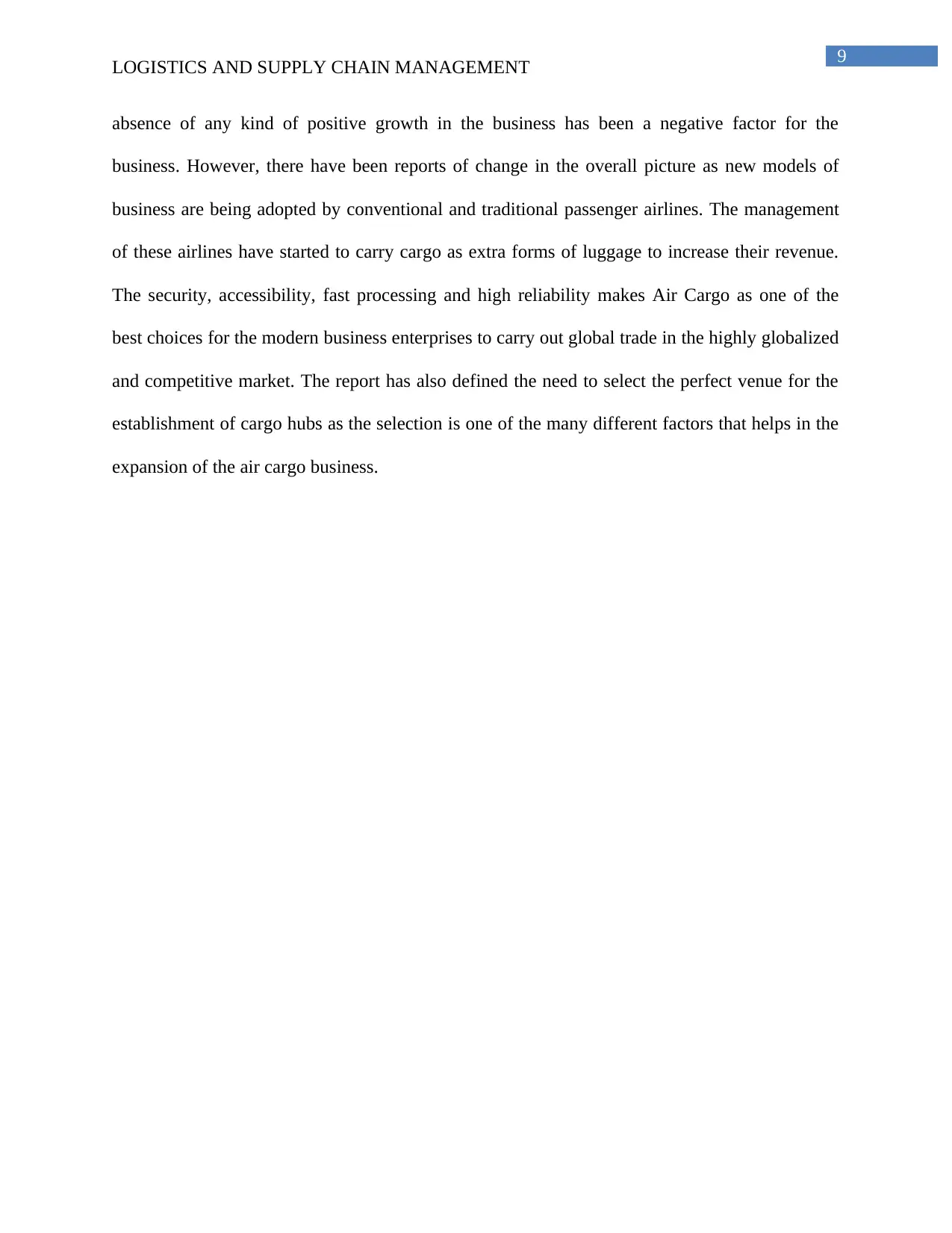
9
LOGISTICS AND SUPPLY CHAIN MANAGEMENT
absence of any kind of positive growth in the business has been a negative factor for the
business. However, there have been reports of change in the overall picture as new models of
business are being adopted by conventional and traditional passenger airlines. The management
of these airlines have started to carry cargo as extra forms of luggage to increase their revenue.
The security, accessibility, fast processing and high reliability makes Air Cargo as one of the
best choices for the modern business enterprises to carry out global trade in the highly globalized
and competitive market. The report has also defined the need to select the perfect venue for the
establishment of cargo hubs as the selection is one of the many different factors that helps in the
expansion of the air cargo business.
LOGISTICS AND SUPPLY CHAIN MANAGEMENT
absence of any kind of positive growth in the business has been a negative factor for the
business. However, there have been reports of change in the overall picture as new models of
business are being adopted by conventional and traditional passenger airlines. The management
of these airlines have started to carry cargo as extra forms of luggage to increase their revenue.
The security, accessibility, fast processing and high reliability makes Air Cargo as one of the
best choices for the modern business enterprises to carry out global trade in the highly globalized
and competitive market. The report has also defined the need to select the perfect venue for the
establishment of cargo hubs as the selection is one of the many different factors that helps in the
expansion of the air cargo business.
⊘ This is a preview!⊘
Do you want full access?
Subscribe today to unlock all pages.

Trusted by 1+ million students worldwide
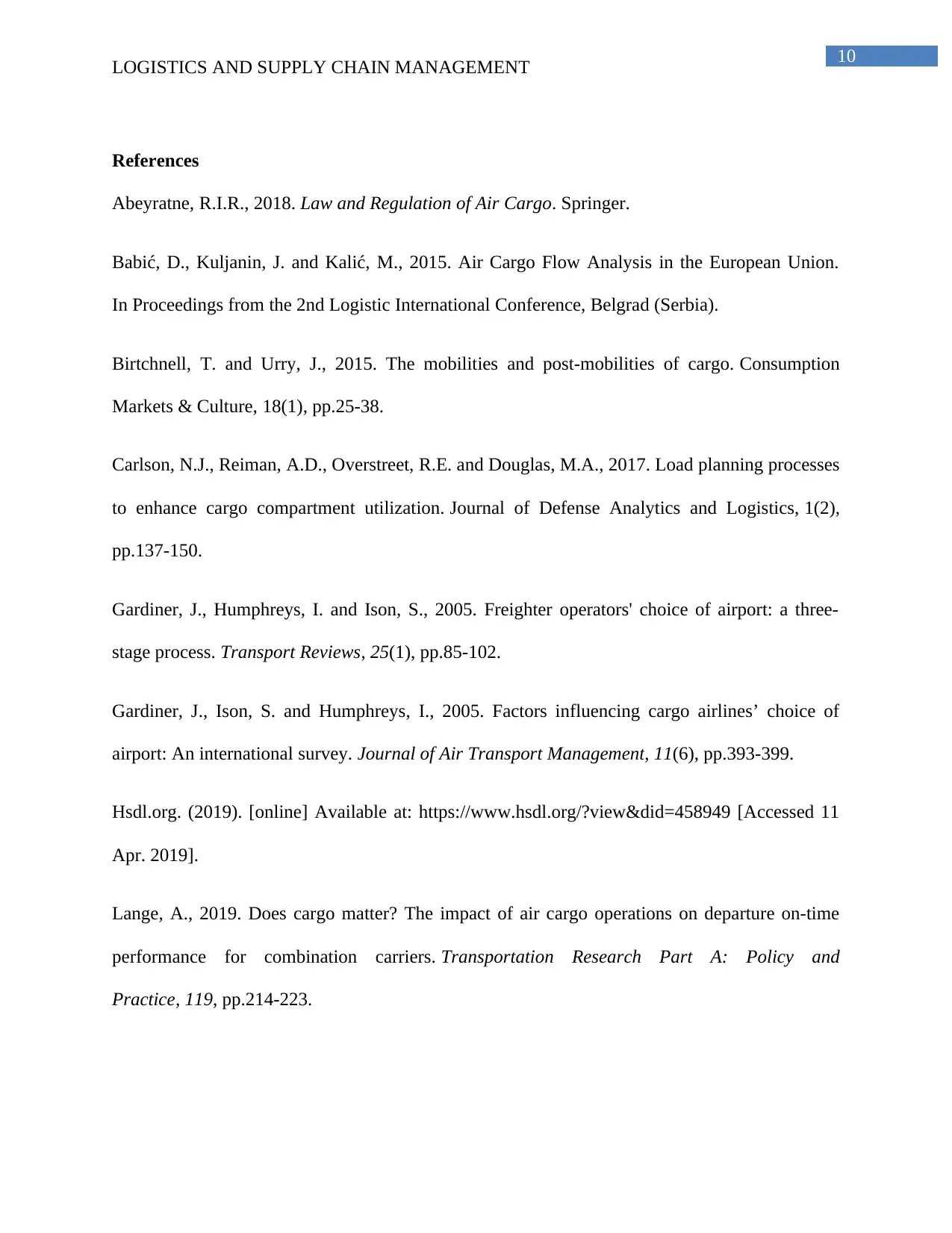
10
LOGISTICS AND SUPPLY CHAIN MANAGEMENT
References
Abeyratne, R.I.R., 2018. Law and Regulation of Air Cargo. Springer.
Babić, D., Kuljanin, J. and Kalić, M., 2015. Air Cargo Flow Analysis in the European Union.
In Proceedings from the 2nd Logistic International Conference, Belgrad (Serbia).
Birtchnell, T. and Urry, J., 2015. The mobilities and post-mobilities of cargo. Consumption
Markets & Culture, 18(1), pp.25-38.
Carlson, N.J., Reiman, A.D., Overstreet, R.E. and Douglas, M.A., 2017. Load planning processes
to enhance cargo compartment utilization. Journal of Defense Analytics and Logistics, 1(2),
pp.137-150.
Gardiner, J., Humphreys, I. and Ison, S., 2005. Freighter operators' choice of airport: a three‐
stage process. Transport Reviews, 25(1), pp.85-102.
Gardiner, J., Ison, S. and Humphreys, I., 2005. Factors influencing cargo airlines’ choice of
airport: An international survey. Journal of Air Transport Management, 11(6), pp.393-399.
Hsdl.org. (2019). [online] Available at: https://www.hsdl.org/?view&did=458949 [Accessed 11
Apr. 2019].
Lange, A., 2019. Does cargo matter? The impact of air cargo operations on departure on-time
performance for combination carriers. Transportation Research Part A: Policy and
Practice, 119, pp.214-223.
LOGISTICS AND SUPPLY CHAIN MANAGEMENT
References
Abeyratne, R.I.R., 2018. Law and Regulation of Air Cargo. Springer.
Babić, D., Kuljanin, J. and Kalić, M., 2015. Air Cargo Flow Analysis in the European Union.
In Proceedings from the 2nd Logistic International Conference, Belgrad (Serbia).
Birtchnell, T. and Urry, J., 2015. The mobilities and post-mobilities of cargo. Consumption
Markets & Culture, 18(1), pp.25-38.
Carlson, N.J., Reiman, A.D., Overstreet, R.E. and Douglas, M.A., 2017. Load planning processes
to enhance cargo compartment utilization. Journal of Defense Analytics and Logistics, 1(2),
pp.137-150.
Gardiner, J., Humphreys, I. and Ison, S., 2005. Freighter operators' choice of airport: a three‐
stage process. Transport Reviews, 25(1), pp.85-102.
Gardiner, J., Ison, S. and Humphreys, I., 2005. Factors influencing cargo airlines’ choice of
airport: An international survey. Journal of Air Transport Management, 11(6), pp.393-399.
Hsdl.org. (2019). [online] Available at: https://www.hsdl.org/?view&did=458949 [Accessed 11
Apr. 2019].
Lange, A., 2019. Does cargo matter? The impact of air cargo operations on departure on-time
performance for combination carriers. Transportation Research Part A: Policy and
Practice, 119, pp.214-223.
Paraphrase This Document
Need a fresh take? Get an instant paraphrase of this document with our AI Paraphraser
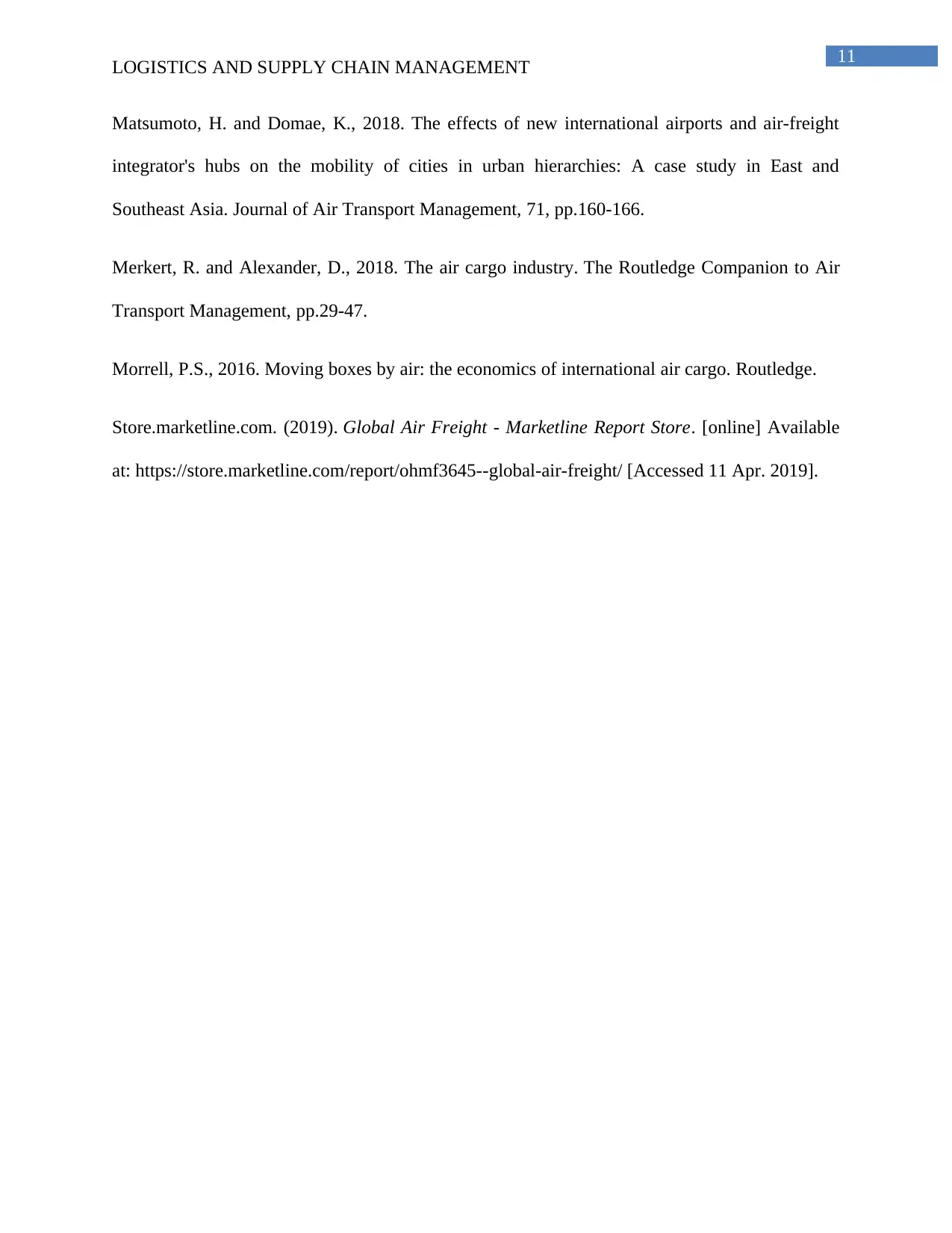
11
LOGISTICS AND SUPPLY CHAIN MANAGEMENT
Matsumoto, H. and Domae, K., 2018. The effects of new international airports and air-freight
integrator's hubs on the mobility of cities in urban hierarchies: A case study in East and
Southeast Asia. Journal of Air Transport Management, 71, pp.160-166.
Merkert, R. and Alexander, D., 2018. The air cargo industry. The Routledge Companion to Air
Transport Management, pp.29-47.
Morrell, P.S., 2016. Moving boxes by air: the economics of international air cargo. Routledge.
Store.marketline.com. (2019). Global Air Freight - Marketline Report Store. [online] Available
at: https://store.marketline.com/report/ohmf3645--global-air-freight/ [Accessed 11 Apr. 2019].
LOGISTICS AND SUPPLY CHAIN MANAGEMENT
Matsumoto, H. and Domae, K., 2018. The effects of new international airports and air-freight
integrator's hubs on the mobility of cities in urban hierarchies: A case study in East and
Southeast Asia. Journal of Air Transport Management, 71, pp.160-166.
Merkert, R. and Alexander, D., 2018. The air cargo industry. The Routledge Companion to Air
Transport Management, pp.29-47.
Morrell, P.S., 2016. Moving boxes by air: the economics of international air cargo. Routledge.
Store.marketline.com. (2019). Global Air Freight - Marketline Report Store. [online] Available
at: https://store.marketline.com/report/ohmf3645--global-air-freight/ [Accessed 11 Apr. 2019].
1 out of 11
Related Documents
Your All-in-One AI-Powered Toolkit for Academic Success.
+13062052269
info@desklib.com
Available 24*7 on WhatsApp / Email
![[object Object]](/_next/static/media/star-bottom.7253800d.svg)
Unlock your academic potential
Copyright © 2020–2025 A2Z Services. All Rights Reserved. Developed and managed by ZUCOL.





